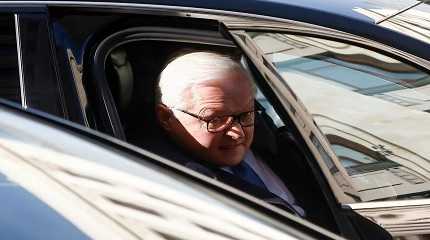
LONDON, Jan 30 (Reuters) - Russia told the United States on Monday that the last remaining pillar of bilateral nuclear arms control could expire in 2026 without a replacement due to what it said were U.S. efforts to inflict "strategic defeat" on Moscow in Ukraine.
Both Russia and the United States still have vast arsenals of nuclear weapons which are currently partially limited by the 2011 New START Treaty, which in 2021 was extended until 2026.
What comes after Feb. 4, 2026, however, is unclear, though Washington has indicated it wants to reach a follow-on agreement with Russia.
Asked if Moscow could envisage there being no nuclear arms control treaty after 2026, Deputy Foreign Minister Sergei Ryabkov told the RIA state new agency: "This is quite a possible scenario."
Ryabkov, Russia's top arms control diplomat, said the United States had in recent years ignored Russia's interests and dismantled most of the architecture of arms control.
"New START may well fall victim to this," Ryabkov told RIA. "We are ready for such a scenario."
His remarks constitute a warning to Washington that its continued military support for Ukraine could scupper the final major post-Cold War bilateral arms control treaty with Russia.
The United States has supplied more than $27 billion in security assistance to Ukraine since Russia invaded the country on Feb. 24, including over 1,600 Stinger anti-aircraft rocket systems, 8,500 Javelin anti-tank missile systems and over 1 million 155mm artillery rounds.
"The entire situation in the sphere of security, including arms control, has been held hostage by the U.S. line of inflicting strategic defeat on Russia," Ryabkov said.
"We will resist this in the strongest possible way using all the methods and means at our disposal."
NUCLEAR CONTROLS
U.S.-Russia talks on resuming inspections under the New START treaty were called off at the last minute in November 2022. The sides have not agreed on a time frame for new talks.
Russia and the United States, which during the Cold War were constrained by a tangle of arms control agreements, still account together for about 90% of the world's nuclear warheads.
The United States said in its 2022 Nuclear Posture Review that Russia and China were expanding and modernising their nuclear forces, and that Washington would pursue an approach based on arms control to head off costly arms races.
The New START Treaty limited both sides to 1,550 warheads on deployed intercontinental ballistic missiles, submarine ballistic missiles and heavy bombers. Both sides met the central limits by 2018.
"Expiration of the Treaty without a follow-on agreement would leave Russia free to expand strategic nuclear forces that are now constrained, as well as novel intercontinental-range and regional systems that are not currently limited by the Treaty," according to the U.S. Nuclear Posture Review.
"Russia is pursuing several novel nuclear-capable systems designed to hold the U.S. homeland or Allies and partners at risk, some of which are also not accountable under New START."




